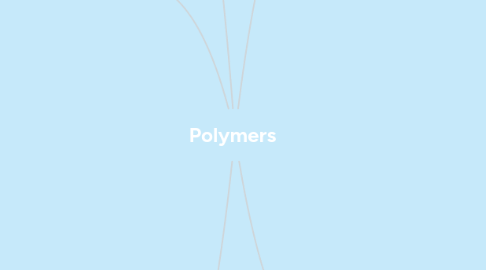
1. Mechanical Behavior
1.1. Stress-Strain Behavior
1.1.1. Can be brittle, plastic or highly elastic
1.1.2. High flexibilities, low densities, high resistance to corrosion
1.1.3. Mechanical properties are sensitive to temperature change and strain rate.
1.2. Viscoelastic Deformation
1.2.1. Intermediate between totally plastic and totally viscous.
1.2.2. Viscoelastic mechanical behavior is displayed by a number of polymeric materials
1.2.3. Characterized by relaxation number
1.3. Fracture Polymers
1.3.1. Fracture strengths low relative to metals and ceramics
1.3.2. Both brittle and ductile modes are possible
1.3.3. Some thermoplastics experience ductile-to-brittle transition with lowering of temperature.
2. Deformation and Strengthening
2.1. Deformation of Semicrystalline Polymers
2.1.1. During elastic deformation of semicrystalline with spherulitic structure stressed in tension, molecules in amorphous regions elongate in direction of stress
2.1.2. Tensile plastic deformation of spherulitic polymer occurs in several stages. Both amorphous tie chains and chain-folded block segments become orientated with tensile axis
2.1.3. During deformation, shapes of spherulites are altered
2.2. Factors That Influence the Mechanical Properties of Semicrystaline
2.2.1. Influenced by both in-service and structural/processing factors
2.2.2. Increasing temperature and/or diminishing strain rate leads to reductions in tensile modulus and tensile strength and enhancements in ductility.
2.2.3. Molecular weight , Degree of crystallinity, Predeformation and heat-treating also affects properties.
2.3. Deformation of Elastomers
2.3.1. Large elastic extensions are possible for elastomeric materials that are amorphous and lightly crosslinked.
2.3.2. Deformation corresponds to the unkinking and uncoiling of chains in response to applied tensile stress.
2.3.3. Crosslinking is often achieved during a vulcanization process; increased crosslinking increases modulus of elasticity and tensile strength.
2.3.4. Many elastomers are copolymers. Silicone elastomers are inorganic materials.
3. Crystallization, Melting and Glass Transition
3.1. Crystallization
3.1.1. During crystallization, randomly orientated molecules in the liquid phase transform into chain folded crystallites that have ordered and aligned molecular structures.
3.2. Melting
3.2.1. The melting of the crystalline regions of a polymer corresponds to the transformation of a solid material having an ordered structure of aligned molecular chains into viscous liquid in which the structure is largely random.
3.3. The Glass Transition
3.3.1. Occurs in amorphous regions.
3.3.2. Upon cooling, liquid gradually transforms into a rubbery material and then finally rigid solid.
3.4. Temperatures
3.4.1. Melting and glass transition temperature can be determined from plots.
4. Polymer Types
4.1. Types
4.1.1. Classified according to the end use
4.2. Plastics
4.2.1. Most widely used group pf polymers. Includes polyethylene, polypropylene, poly vinyl chloride, polystyrene and the flourocarbons, epoxies,phenolics and polyesters
4.3. Fibers
4.3.1. Used primarily in textiles. Mechanical , thermal , and chemical characteristics of these materials are especially critical.
4.4. Advanced Polymeric Materials
4.4.1. These include Ultra-high-molecular-weight Polyethylene Liquid Crystal Polymers Thermoplastic Elastomers
4.4.2. These materials have unusual properties and are used in a host of high-technology applications.
5. Synthesis and Processing
5.1. Forming Techniques for Plastics
5.1.1. Usually accomplished by shaping the material in molten form at an elevated temperature, using one or more techniques; compression, injection,transfer, and blow. Extrusion and casting are also possible
5.2. Polymerization
5.2.1. Addition Polymerization: Monomer units are attached to one at a time in a chain like fashion to form a linear molecule.
5.2.2. Condensation Polymerization: Involves stepwise inter-molecular chemical reactions that may include more than a single molecular species
5.3. Polymer Additives
5.3.1. Properties of polymers can be further enhanced using polymers.
5.3.2. Fillers are added to improve strength, abrasion resistance, and/or thermal/dimensional stability of polymers.
5.3.3. Flexibility, ductility and toughness are enhanced by the addition of plasticizes
5.3.4. Stabilizers counteract the decorative processes due to exposure to light and gaseous species in the atmosphere
5.3.5. Colourants are used to add colour to polymers
5.3.6. Flammability resistance are enhanced by adding flame retardants.
5.4. Fabrication of Fibers and Films
5.4.1. Certain fibers are spun from a viscous melt or solution, after which they are plastically elongated during a drawing operation, this improves mechanical strength.
5.4.2. Films are formed by extrusion and blowing or by calendering.
